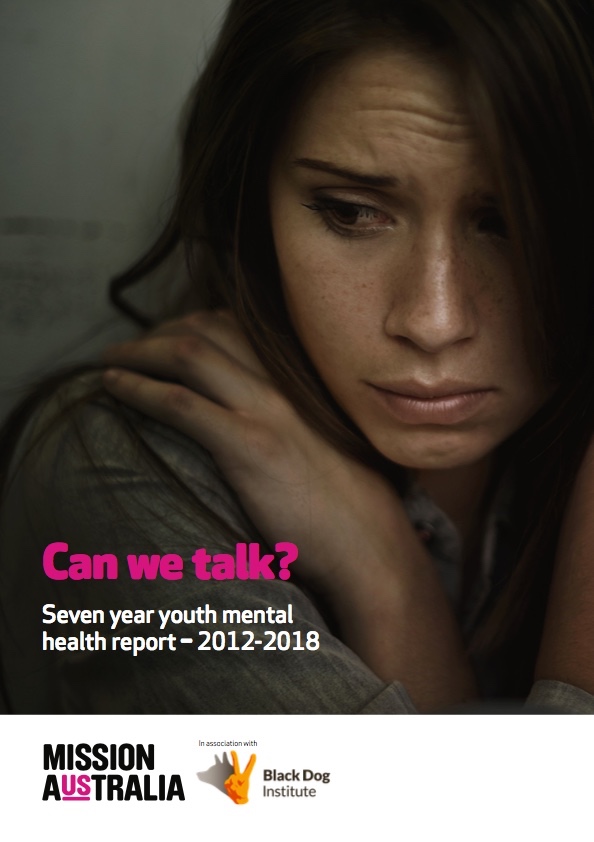More young people in Australia are experiencing psychological distress than was the case seven years ago, according to a new joint report from Mission Australia and the Black Dog Institute.
The report, Can we talk? Seven year youth mental health report – 2012-2018, shows that almost a quarter (24.2 per cent) of young people aged 15 to 19 said they were experiencing mental health challenges in 2018, up from 18.7 per cent in 2012.

The Mission Australia/Black Dog Institute report cover.
The report, which drew on the findings of Mission Australia’s Youth Survey, also shows that, looking across the seven years from 2012, females were almost twice as likely as males to experience psychological distress. Figures show the increase in females reporting psychological distress rose from 22.5 per cent in 2012 to 30 per cent in 2018 compared to the rise among males – from 12.7 per cent to 15.6 per cent.
Meanwhile, almost a third (31.9 per cent) of Aborginal and Torres Strait Islander young people met the criteria for psychological distress in 2018, according to the report, compared with 23.9 per cent among non-Indigenous young people.
James Toomey, Mission Australia’s CEO, described the findings as “deeply disturbing” and said youth mental health is a “serious national challenge that must be tackled as a priority”.
“The sheer volume of young people who are struggling with mental health difficulties shows that there remains urgent need for improved access to timely, accessible and appropriate support,” he said in comments released with the report.
“Irrespective of their location, background or gender, young people must have the resources they need to manage their individual mental health journey with access to youth-friendly and evidence-based mental health supports.”
Other findings in the report show:
• The largest increases in the proportion of young people with psychological distress can be been seen among both the youngest and the oldest age groups, with an increase of six per cent among 15-year-olds (from 17.1 per cent in 2012 to 23.1 per cent in 2018) and an increase of 8.8 per cent among 18 to 19-year-olds (18.2 per cent in 2012 to 27 per cent in 2018);
• Young people reporting psychological distress were 12 times more likely to indicate feeling as though they had no control over their life as others (10.8 per cent compared to 0.9 per cent);
• The top three issues of personal concern for young people with psychological distress were ‘coping with stress’ (74.3 per cent), ‘mental health’ (62.7 per cent) and ‘school or study problems’ (55.4 per cent) while among respondants without psychological distress, the top concerns were ‘coping with stress’ (33.5 per cent), ‘school or study problems’ (27 per cent) and ‘body image’ (22.6 per cent);
• Some 36.5 per cent of young people with psychological distress reported having issues they did not seek help for compared with seven per cent of those without psychological distress;
• The two most commonly cited sources of help for all respondants were ‘friends’, and ‘parents and guardians’ while for those with psychological distress the third most common was the ‘internet’ and for those without it was a ‘relative or family friend’; and,
• ‘Stigma and embarrassment’, ‘fear’, and ‘a lack of support’ were the three most commonly cited barriers that young people reported as preventing them from getting the help they need.
Mission Australia’s Toomey has called for greater resourcing for schools to train staff, embed wellbeing personnel and provide evidence-based early intervention and prevention programs.
Professor Helen Christensen, Black Dog Institute director and chief scientist, said the report shows young people in distress will seek help using the internet.
“As such, we need to continue to provide online and app-based tools that may be a key part of the solution,” she said. “We also need to catch the problems upstream by prioritising early intervention and prevention efforts.”
Correction: The name of Mission Australia’s CEO has been corrected to James Toomey.






